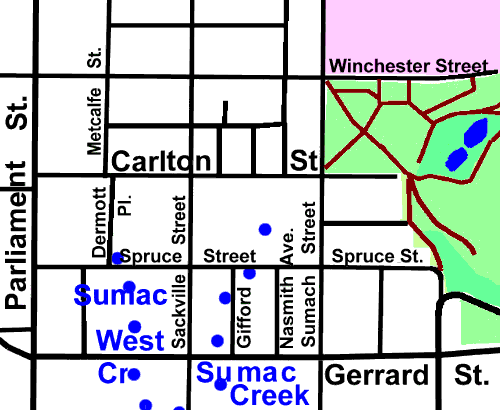Return to Don Channel Reach main page.
Cabbagetown is now considered to be the area bounded by Sherbourne Street on the west Gerrard Street on the south, the Don River on the east and Wellesley Street on the north. But it was not always so. The original Cabbagetown actually lay to the south, mostly in the area now called Regent Park: between Gerrard Street on the north, Queen Street on the south, and between Parliament Street on the west and the Don River on the east. This was one of the poorest neighbourhoods in Toronto, so, in the name of social housing, most of the old housing was razed to make room for the Regent Park housing project. Then the name “Cabbagetown” was moved north to the Victorian neighbourhood to which it is now applied. According to the Cabbagetown Preservation Association, the present neighbourhood comprises “the largest continuous area of preserved Victorian housing in North America”. Many of the original Victorian homes still stand and have been beautifully restored. In 2004, the present-day Cabbagetown was made a Heritage Conservation District, protected by municipal bylaw.

There are a number of somewhat similar stories about how “Cabbagetown” got its name. The essence is that poor immigrants in the late nineteenth century could only afford to eat the cabbage they grew themselves, in their front yards. The Immigrants are variously described as Irish, Polish, Anglo-Celtic and Macedonian. While they are usually said to be Roman Catholics, the majority of the population was as a matter of fact mostly Protestant and English speaking. On one website I found a note from Eileen McBride, who tells us that she was born and grew up in Cabbagetown, where her grandfather told her this anecdote. “It seems that the mayor, running for re-election, was visiting the area with other dignitaries & newspapermen, when they stopped at one cottage and asked a woman there why did she have cabbages growing there. She told them that she also grew potatoes in the backyard, but the cabbages were prettier to look at in the front yard. The then mayor replied ‘what a lovely little town of cabbages.’ When the daily paper came out next day the headlines read ‘mayor visits cabbagetown.’ The name stuck and represents all the immigrants that have lived there with their lovely heads of cabbage.” She added “I hope this tale is true as it is more romantic and Irish to boot.”
The Toronto General Hospital opperated here on Gerrard Street, from 1856 to 1914, in a building now demolished. There are many historic buildings in this area, which will not be described.
You may wish to visit this website for more information about Cabagetown.
“Cabbagetown Remembered” by George Rust-D’Eye has much interesting information on Cabbagetown and nearby sites. Some of this information came from: “The Cabbagetown Store” by J.V. McAree, The Ryerson Press, Toronto. 1953.
Riverdale Farm on the east side of this area, the site of Toronto’s first zoo, the west Riverdale woodland, established by The Task Force to Bring Back The Don, Spruce Court Apartments and The Necropolis. are also of interest.
Except for a commercial strip along Parliament, and the parks, this is an area of homes, largely late Victorian. The exceptions include the Spruce Court Coop and the early twentieth century houses that have taken the place of the Toronto General Hospital. Tree cover varies greatly. In the Old Victorian housing areas it is fair and similar to other areas in this part of the city, with Silver and Norway Maple, Horse Chestnut, Honey Locust, Linden, and the occasional Spruce, Elm, White Pine and Yew.
While this area originally drained to the Don River either directly or via Sumac Creek, now storm water goes to the Don via a storm sewer along Gerrard Street. Sanitary sewage flows to the Ashbridge’s STP via the Mid Toronto Interceptor Sewer.
To see points of interest hot spots and main sewers pass mouse over map.
